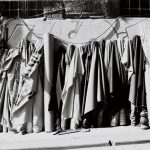As a fabric sourcing manager in Bangladesh, you’ll find and secure quality fabrics that balance cost and sustainability while meeting production deadlines. You negotiate prices, manage supplier relationships, and guarantee strict quality control, all while traversing market trends and supply chain risks. You’ll also leverage technology for better forecasting and supplier tracking. Balancing these responsibilities keeps your supply chain resilient and efficient. Keep exploring to uncover how each of these areas shapes impactful fabric sourcing.
Table of Contents
Key Takeaways
- Identify and procure quality fabrics aligning with company standards, cost targets, and sustainability goals for garment production in Bangladesh.
- Analyze market trends and raw material prices to forecast demand and negotiate competitive prices with suppliers.
- Manage supplier relationships through regular communication, quality inspections, and timely order tracking to ensure on-time delivery.
- Enforce strict quality control protocols and conduct supplier audits to maintain compliance with safety and environmental regulations.
- Utilize technology and data-driven tools for efficient sourcing, risk management, and monitoring of supplier performance and market fluctuations.
Overview of Fabric Sourcing in Bangladesh
Although Bangladesh is best known for its garment manufacturing, fabric sourcing plays an essential role in the country’s textile industry.
When you explore fabric sourcing here, you’ll see a complex network of suppliers, mills, and traders working together to meet global demand. You need to understand the local and international fabric markets, quality standards, and lead times to succeed.
Fabric sourcing in Bangladesh isn’t just about buying materials—it’s about ensuring consistency, affordability, and sustainability. You’ll also navigate challenges like fluctuating raw material prices and supply chain disruptions.
Key Responsibilities of a Fabric Sourcing Manager
Managing fabric sourcing in Bangladesh means balancing numerous tasks that keep the supply chain running smoothly. You’re responsible for identifying quality fabrics that meet your company’s standards while guaranteeing cost-effectiveness.
Balancing quality and cost-effectiveness is key to smooth fabric sourcing in Bangladesh.
You’ll analyze market trends to make informed purchasing decisions and forecast demand accurately to avoid shortages or overstock. Monitoring fabric quality through inspections and tests is vital to maintain product standards.
You’ll also handle order placements, track shipments, and coordinate with logistics teams to guarantee timely delivery. Budget management falls under your scope, requiring you to negotiate prices within set limits and optimize costs without compromising quality.
Additionally, you must stay updated on regulatory compliance and environmental standards to align sourcing practices with local and international requirements.
Managing Supplier Relationships Effectively
Building strong supplier relationships plays an essential role in securing reliable fabric sources and ensuring smooth operations.
You need to communicate clearly and regularly with your suppliers to understand their capabilities and address any potential challenges early. By fostering trust and transparency, you can negotiate better terms and encourage suppliers to prioritize your orders.
It’s vital to stay proactive—monitor delivery schedules and resolve issues promptly to avoid production delays. Also, showing appreciation for good performance strengthens partnerships, making suppliers more willing to collaborate during tight deadlines.
Ensuring Quality Control and Compliance
You need to enforce strict quality standards to keep your fabric sourcing on point.
Staying updated with regulatory compliance and monitoring every step is essential.
Regular inspections and testing protocols help catch issues before they become costly problems.
Quality Standards Enforcement
When sourcing fabric in Bangladesh, guaranteeing quality standards becomes essential to maintain product integrity and meet client expectations. You need to implement strict inspection procedures at every stage—from raw material selection to final fabric delivery.
Regularly auditing suppliers helps guarantee they adhere to agreed-upon quality benchmarks. Use standardized testing methods to assess fabric strength, colorfastness, and texture, addressing any deviations immediately.
Collaborate closely with your quality control team to monitor production processes, preventing defects before they escalate. Clear communication with suppliers about quality expectations minimizes misunderstandings and reduces rework.
Regulatory Compliance Monitoring
Maintaining quality standards goes hand in hand with staying compliant with local and international regulations. As a fabric sourcing manager in Bangladesh, you need to continuously monitor regulatory changes to guarantee your materials meet safety, environmental, and labor laws.
You’ll coordinate with suppliers to verify certifications, such as OEKO-TEX or REACH, and confirm that fabrics don’t contain banned substances. Keeping detailed records of compliance helps you demonstrate accountability during audits.
You must also stay updated on export-import guidelines to avoid legal complications. By proactively managing compliance, you protect your company’s reputation and reduce risks of penalties or shipment delays.
Your vigilance guarantees that every fabric you source aligns with both industry standards and government requirements, reinforcing trust with clients and partners.
Inspection and Testing Protocols
Although sourcing high-quality fabrics is essential, implementing rigorous inspection and testing protocols guarantees consistent quality and compliance throughout the supply chain.
You’ll need to establish clear criteria for fabric quality, including colorfastness, strength, shrinkage, and texture. Regular inspections at various production stages help catch defects early, reducing costly rework or returns.
Conducting lab tests verifies that fabrics meet safety and regulatory standards, such as chemical content limits. You should also collaborate closely with suppliers to ascertain they understand and follow these protocols.
Documenting all inspection results keeps your quality control transparent and traceable. By enforcing strict inspection and testing procedures, you maintain product integrity, satisfy customer expectations, and uphold Bangladesh’s reputable position in the global textile market.
Negotiating Prices and Contract Terms
Because fabric sourcing plays an essential role in your supply chain, negotiating prices and contract terms demands careful strategy and clear communication. You need to balance cost efficiency with quality and reliability.
Start by researching market rates and understanding supplier capabilities to set realistic expectations. When discussing prices, be firm but fair, aiming for a win-win agreement that fosters long-term relationships.
Clearly outline contract terms, including payment schedules, delivery deadlines, and quality standards, to avoid misunderstandings. Don’t hesitate to negotiate penalties for delays or defects, ensuring accountability.
Always document agreed terms meticulously and confirm mutual understanding before finalizing contracts. Your negotiation skills directly impact your company’s profitability and production flow, so approach each discussion prepared and professional.
Coordinating Timely Fabric Deliveries
When you coordinate fabric deliveries effectively, you guarantee your production line keeps moving without costly delays.
You must maintain clear communication with suppliers to confirm shipment schedules and promptly address any changes. Tracking orders closely helps you anticipate arrival times and adjust production plans if needed.
Maintain clear communication with suppliers and track orders closely to anticipate arrivals and adjust production plans.
You’ll also coordinate with logistics partners to guarantee smooth transit from supplier to factory. Establishing buffer times for unexpected hold-ups can prevent disruptions.
Using technology like inventory management systems allows you to monitor stock levels and delivery statuses in real time. By staying proactive and organized, you minimize downtime and keep production on schedule, which is vital in Bangladesh’s fast-paced textile industry.
Your role is key to maintaining a steady fabric supply and meeting tight deadlines consistently.
Assessing and Mitigating Supply Chain Risks
Since fabric sourcing in Bangladesh involves multiple moving parts, you need to actively assess and mitigate supply chain risks to avoid costly disruptions.
Start by identifying potential risks like political instability, supplier reliability, and transportation delays. Then, develop contingency plans tailored to each risk to keep your supply chain resilient.
Focus on these key strategies:
- Conduct regular supplier audits to guarantee quality and reliability
- Diversify your supplier base to reduce dependency on a single source
- Monitor geopolitical and environmental factors that could impact logistics
Incorporating Sustainability in Fabric Sourcing
You need to prioritize sustainable material selection to reduce environmental impact in your fabric sourcing.
Building ethical supplier partnerships guarantees fair labor practices and transparency throughout your supply chain.
Sustainable Material Selection
Choosing sustainable materials plays an essential role in reducing the environmental impact of your fabric sourcing. You need to prioritize fabrics that minimize water use, chemical inputs, and waste.
Opting for organic cotton, recycled polyester, or Tencel can greatly lower your carbon footprint. When selecting materials, consider the entire lifecycle—from cultivation to disposal.
Focus on these key factors:
- Renewability: Choose fibers derived from renewable resources that replenish quickly.
- Biodegradability: Prefer materials that break down naturally to avoid long-term pollution.
- Resource Efficiency: Select fabrics produced with minimal water and energy consumption.
Ethical Supplier Partnerships
Build strong ethical supplier partnerships to assure your fabric sourcing supports sustainability throughout the supply chain.
You should carefully vet suppliers to confirm they comply with labor laws, environmental standards, and fair trade practices.
Prioritize working with vendors who share your commitment to reducing waste, using renewable resources, and maintaining transparency.
Regular audits and clear communication help you monitor compliance and address any issues promptly.
By fostering long-term relationships based on trust and shared values, you not only improve social and environmental impact but also secure consistent quality and reliability.
Utilizing Technology and Data Analytics
Although traditional methods have long dominated fabric sourcing in Bangladesh, leveraging technology and data analytics can transform how you manage suppliers, forecast demand, and optimize costs.
You can gain real-time insights into supplier performance and delivery timelines, allowing you to spot potential bottlenecks early. Data-driven forecasting helps you accurately predict fabric needs, reducing overstock and waste.
Additionally, technology streamlines communication and documentation, improving transparency and efficiency.
Here’s how you can benefit:
- Use software tools to track and evaluate supplier reliability and quality.
- Analyze historical purchase data to anticipate fabric requirements.
- Implement digital platforms for seamless order processing and supplier collaboration.
Embracing these tools not only boosts your sourcing efficiency but also strengthens your decision-making accuracy.
Handling Price Fluctuations and Market Trends
You need to keep a close eye on global fabric prices to stay ahead.
Tracking seasonal market trends helps you anticipate shifts and adjust your plans accordingly.
Monitoring Global Fabric Prices
Since fabric prices can shift rapidly due to global events and supply chain disruptions, you need to track market trends closely to stay competitive.
Monitoring global fabric prices helps you anticipate cost changes and negotiate better deals. Use real-time data and reliable sources to stay updated on price movements.
Focus on:
- Tracking raw material costs like cotton and polyester, which directly affect fabric prices
- Monitoring currency fluctuations impacting international trade expenses
- Staying informed about geopolitical issues that could disrupt supply chains
Analyzing Seasonal Market Trends
When fabric demand shifts with the seasons, analyzing market trends becomes essential to managing price fluctuations effectively. You need to track which fabrics gain popularity during specific times, like cotton in summer and wool in winter.
By studying past sales data and current market reports, you can anticipate demand spikes or drops. This foresight helps you negotiate better prices and secure materials before costs rise.
Keep an eye on external factors like weather changes, festivals, or fashion cycles that influence buying patterns. Staying proactive allows you to adjust sourcing strategies promptly, minimizing risks of overstocking or shortages.
Ultimately, your ability to read seasonal trends guarantees your supply chain remains stable and cost-efficient throughout the year.
Developing Strategic Pricing Plans
Although market prices can swing unpredictably, developing strategic pricing plans helps you stay ahead of fluctuations and capitalize on trends. You need to analyze cost drivers like raw material availability and global demand to set flexible pricing structures. By doing this, you guarantee your sourcing remains competitive and profitable despite market volatility.
Focus on these key actions:
- Monitor real-time market data to anticipate price shifts
- Negotiate with suppliers for fixed rates or volume discounts
- Adjust pricing strategies seasonally to align with demand cycles
Staying proactive allows you to manage risks effectively and seize opportunities when prices drop. Your strategic pricing plan becomes a crucial tool in maintaining stable profit margins while adapting to Bangladesh’s dynamic fabric market.
Skills and Qualifications Required for Success
To excel as a Fabric Sourcing Manager in Bangladesh, you need a strong mix of technical knowledge and interpersonal skills. Understanding fabric types, supply chains, and quality standards is vital, while communication and negotiation skills help you build strong supplier relationships. You must be detail-oriented, adaptable, and able to analyze market trends effectively.
| Skill/Qualification | Importance |
|---|---|
| Textile Knowledge | Guarantees fabric quality control |
| Negotiation Skills | Secures favorable contracts |
| Market Analysis | Identifies cost-saving trends |
| Communication | Builds supplier rapport |
| Problem-Solving | Handles sourcing challenges |
Frequently Asked Questions
How Does a Fabric Sourcing Manager Handle Cultural Differences With International Suppliers?
You handle cultural differences with international suppliers by communicating clearly, respecting their customs, and showing flexibility. You’ll build trust by learning about their culture and adapting your approach to foster strong, effective partnerships.
What Are Common Challenges in Sourcing Specialty Fabrics in Bangladesh?
You’ll face challenges like finding rare specialty fabrics that seem rarer than unicorns, dealing with inconsistent quality, maneuvering limited supplier options, and managing longer lead times—all while negotiating prices and ensuring timely delivery in a competitive market.
How Do Fabric Sourcing Managers Stay Updated on Emerging Textile Innovations?
You stay updated on textile innovations by attending trade shows, networking with suppliers, subscribing to industry publications, and participating in webinars. These actions help you spot trends and source the latest fabrics efficiently.
What Role Does a Fabric Sourcing Manager Play in Product Development?
Imagine you’re a chef selecting ingredients; as a fabric sourcing manager, you play a similar role, choosing materials that shape designs, ensuring quality and cost-effectiveness, directly influencing the final product’s success and appeal.
How Do Fabric Sourcing Managers Balance Cost Versus Ethical Sourcing Demands?
You balance cost and ethics by researching suppliers thoroughly, negotiating fair prices, and prioritizing sustainable materials. You also stay updated on industry standards, ensuring your sourcing decisions support both budget constraints and responsible practices.
- Does Chiffon Fabric Stink - July 15, 2025
- Does Chiffon Fabric Affect the Economy - July 15, 2025
- Does Cotton Fabric Have a Nap - July 15, 2025






